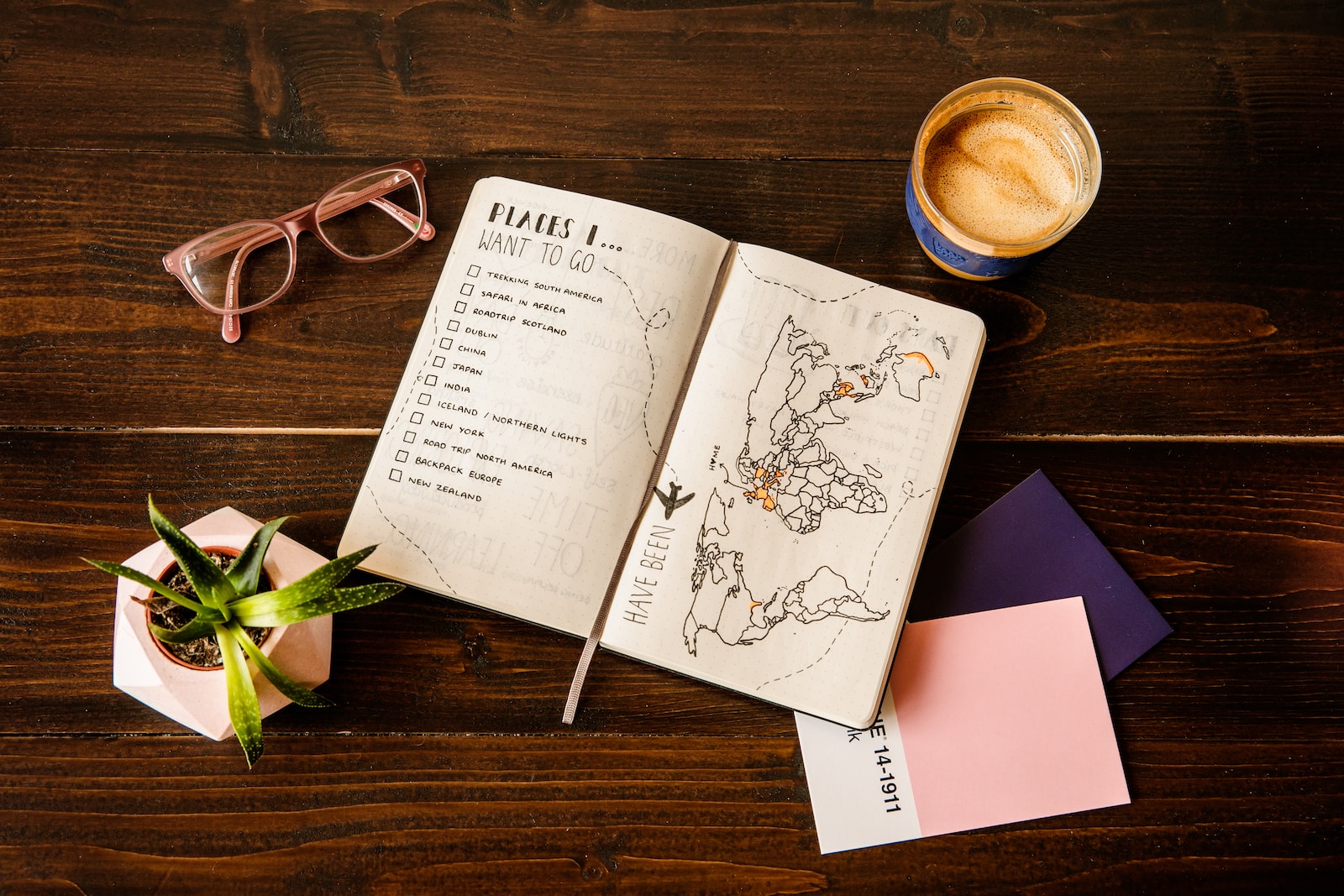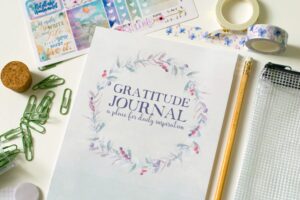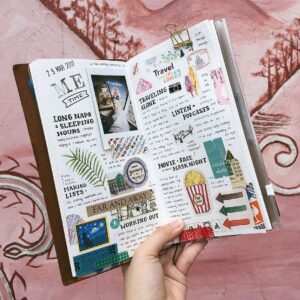As someone who loves to stay organized and productive, I have always been on the lookout for new ways to manage my schedule and achieve my goals. That’s why I was so excited to discover bullet journaling. In this bullet journaling for beginners guide, I’ll introduce you to the basics of bullet journaling, share some tips for getting started, and explore the many benefits of this magical practice.
Bullet Journaling for Beginners: An Introduction
If you’re not familiar with bullet journaling, you might be wondering what all the fuss is about. Simply put, bullet journaling is a customizable organizational system that can help you keep track of your to-do lists, appointments, goals, and more. It’s a way to combine creativity with productivity, using a notebook and a simple set of symbols to help you stay on track.
Bullet journaling for beginners should focus on the benefits this process offers. The beauty of bullet journaling is that it can be tailored to your specific needs and preferences. Whether you’re a busy professional, a student, or a stay-at-home parent, you can adapt the system to work for you. And the best part? You don’t have to be an artist to create a beautiful and functional bullet journal.
What is Bullet Journaling?
At its core, bullet journaling is a method of rapid logging. Instead of writing out long paragraphs or sentences, you use a series of symbols to represent different types of information. For example, a dot might represent a task on your to-do list, while a circle might represent an event on your calendar. You can also add notes, arrows, and other symbols to indicate the status of a task, the priority level, and more.
One of the key features of bullet journaling is the index. This is a table of contents that you create as you go along, allowing you to easily find specific pages or information later on. You can also use page numbers to help you navigate your journal.
Another important aspect of bullet journaling is collections. These are pages that are dedicated to specific topics or projects, such as a list of books you want to read, a gratitude log, or a workout tracker. You can create collections as needed and add to them over time.
Benefits of Bullet Journaling

Now that you have a basic understanding of what bullet journaling is, let’s talk about the many benefits of this practice. Here are just a few:
- Increased productivity. By keeping all of your to-do lists, appointments, and notes in one place, you can stay more organized and get more done.
- Improved focus. With a clear sense of what you need to do each day, you can avoid getting distracted by other tasks or obligations.
- Reduced stress. When you have a system in place for managing your time and tasks, you can feel more in control and less overwhelmed.
- Enhanced creativity. Bullet journaling allows you to express your creativity and personalize your journal to reflect your unique style and interests.
- Better goal setting. By tracking your progress toward specific goals, you can stay motivated and make meaningful progress over time.
The Basics of Bullet Journaling for Beginners
Now that you know what bullet journaling is and why it’s so beneficial, let’s dive into the basics of how to get started. Here are the key steps:
- Choose a notebook: You can use any notebook or journal for bullet journaling, but many people prefer to use a notebook with dotted or grid paper for easier customization.
- Create an index. Reserve the first few pages of your notebook for your index, and add to it as you go along.
- Set up your key. Decide on a set of symbols that you will use to represent different types of information in your journal. For example, a dot might represent a task, an arrow might represent a migrated task, and a star might represent a priority item.
- Create your future log: This is a page or spread where you can record upcoming events or tasks for the next few months.
- Set up your monthly log: This is a page or spread where you can record tasks, events, and notes for the current month.
- Create your daily log. This is where you will record your tasks, events, and notes for each day. You can also migrate tasks from previous days or add new tasks as they come up.
Setting up Your Bullet Journal
Bullet journaling for beginners does not have to be complicated. In fact, it’s really quick and simple. Once you have the basics down, it’s time to start customizing your bullet journal to fit your needs and preferences. Here are some ideas to get you started:
- Add collections. Create pages for specific topics or projects that you want to track, such as a reading list, a travel itinerary, or a fitness tracker.
- Decorate your pages. Use stickers, washi tape, or hand-drawn elements to add some visual interest to your pages.
- Use color-coding: Assign different colors to different types of tasks or events to make them easier to distinguish at a glance.
- Experiment with layouts. Try out different page layouts to find what works best for you. Some people prefer a minimalist approach, while others enjoy adding lots of decorative elements.
- Include inspirational quotes or affirmations. Add some motivational quotes or positive affirmations to your pages to keep you inspired and focused.
Bullet Journaling for Beginners: Ideas and Inspiration
If you’re looking for some inspiration for your own bullet journal, there are plenty of resources available online. Here are a few ideas to get you started:
- Pinterest. Pinterest is a treasure trove of bullet journaling ideas, with thousands of pins and boards dedicated to the practice.
- Instagram. There are countless bullet journaling accounts on Instagram, showcasing beautiful and creative journals from around the world.
- Bullet Journal Blogs. There are many blogs dedicated to bullet journaling, offering tips, inspiration, and tutorials for all levels of experience.
- Bullet Journal Communities. There are also online communities and forums where you can connect with other bullet journal enthusiasts and share your own ideas and inspiration.
Tips for Maintaining Your Bullet Journal
Once you’ve started your bullet journal, it’s important to keep up with it in order to get the most benefit. Here are some tips for maintaining your journal:
- Make it a daily habit: Set aside a few minutes each day to update your bullet journal so that it becomes a regular part of your routine.
- Review and migrate tasks regularly. At the end of each day or week, review your tasks and migrate any that you haven’t completed to the next day or week.
- Be flexible. Remember that your bullet journal is a flexible system, so don’t be afraid to make changes or adjustments as needed.
- Don’t get too caught up in perfection. Your bullet journal doesn’t have to be perfect or Instagram-worthy. Focus on using it as a tool for productivity and organization rather than a showcase for your artistic skills.
Advanced Bullet Journaling Techniques
Once you’ve mastered the basics of bullet journaling, there are many advanced techniques that you can explore to take your journal to the next level. Here are a few ideas:
- Habit tracking. Use your bullet journal to track daily habits such as exercise, meditation, or reading.
- Goal setting. Create pages dedicated to specific goals and track your progress toward achieving them over time.
- Mood tracking. Use your bullet journal to track your mood each day and look for patterns or triggers that may be impacting your mental health.
- Gratitude logging. Create a page dedicated to recording things that you’re grateful for each day or week to cultivate a more positive mindset.
- Brainstorming: Use your bullet journal to brainstorm ideas for projects, goals, or creative pursuits.
Improving Productivity and Goal Setting
One of the most powerful aspects of bullet journaling is its ability to help you stay productive and focused on your goals. Here are some tips for using your journal for productivity and goal-setting:
- Break down big goals. If you have a big goal that you’re working toward, break it down into smaller, more manageable tasks that you can tackle one at a time.
- Assign deadlines: Set deadlines for your tasks and goals and hold yourself accountable for meeting them.
- Prioritize tasks. Use your bullet journal to prioritize your tasks each day so that you’re focusing on the most important items first.
- Celebrate progress. When you make progress toward a goal, take time to celebrate and acknowledge your hard work.
Benefits for Mental Health and Self-Care
Another powerful way to use your bullet journal is for mental health and self-care. Here are some ideas:
- Track your mood. Use your bullet journal to track your mood each day and look for patterns or triggers that may be impacting your mental health.
- Create a self-care plan. Create a page dedicated to self-care and brainstorm ideas for activities or practices that help you feel calm and centered.
- Write affirmations or mantras. Use your bullet journal to write down affirmations or mantras that help you feel more positive and empowered.
- Record gratitude. Create a gratitude log where you can record things that you’re grateful for each day or week to cultivate a more positive mindset.
Bullet Journaling for Creative Expression
Finally, bullet journaling can be a wonderful outlet for creative expression. Here are some ideas:
- Doodle: Use your bullet journal to practice your doodling skills and add hand-drawn elements to your pages.
- Write poetry or prose: Use your journal to write down your thoughts, feelings, and creative ideas in the form of poetry or prose.
- Create art pages: Dedicate pages in your journal to creating art, whether it’s painting, drawing, or collage.
- Use stickers and washi tape: Add some visual interest to your pages by using stickers, washi tape, or other decorative elements.
Supplies and Resources
If you’re ready to get started with bullet journaling, you’ll need a few basic supplies. Here are some suggestions:
- Notebook: Any notebook or journal will work, but some popular options include the Leuchtturm 1917, the Moleskine notebook, or the Archer and Olive notebook.
- Pens: You’ll want a set of pens in different colors and sizes for writing and doodling. Some popular options include the Sakura Pigma Micron pens and the Staedtler Triplus Fineliner pens.
- Ruler: A ruler can help you create straight lines and grids in your journal.
- Decorative elements: Optional supplies include stickers, washi tape, and other decorative elements to add some flair to your pages.
Conclusion
Bullet journaling is a magical practice that can help you stay organized, focused, and inspired. Whether you’re a seasoned planner or a complete beginner, there’s no better time to start your own bullet journal. With the tips and ideas shared in this guide, you’ll be well on your way to creating a beautiful and functional journal that helps you achieve your goals and live your best life.
So what are you waiting for? Grab a notebook and some pens and start exploring the magic of bullet journaling today!




No comments! Be the first commenter?